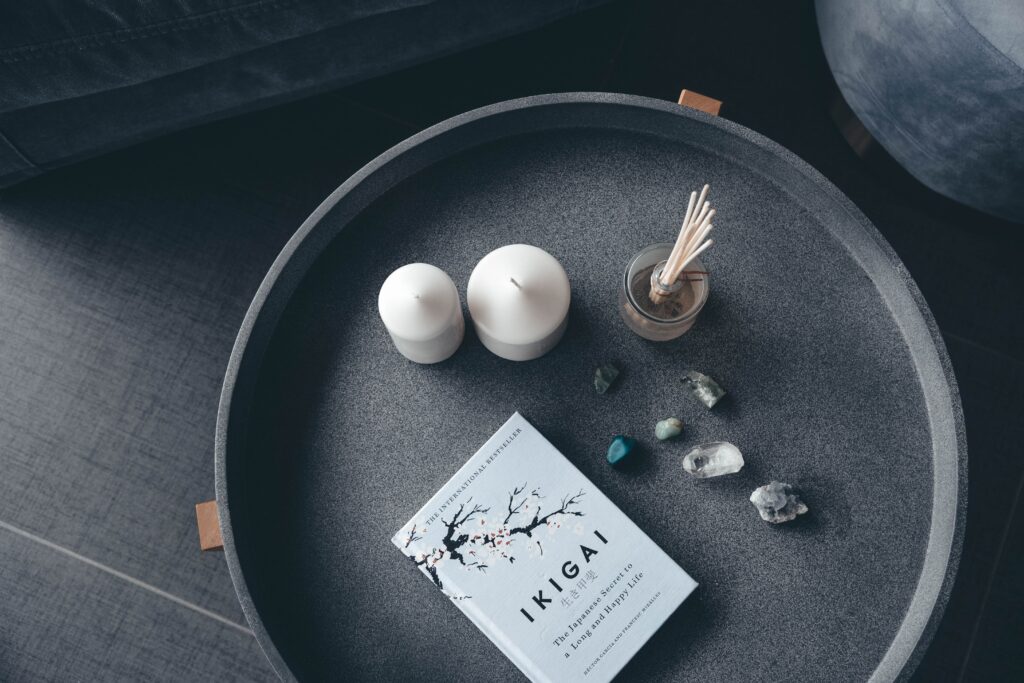In the midst of our bustling lives, filled with endless responsibilities and countless distractions, it’s easy to lose sight of our true purpose. That’s where Ikigai, a profound Japanese concept, comes into play. Originating from the Japanese words “iki” (life) and “gai” (value), explore Ikigai examples, which encompass the essence of finding your reason for being, the sweet spot where passion, mission, vocation, and profession intersect.
Japan, known for its longevity and exceptionally high quality of life, has long held the secret to the wellspring of human existence — the concept of Ikigai. Japanese people have woven Ikigai into the very fabric of their lives, enriching their existence, nurturing their spirits, and forging an unbreakable connection between their passions, their professions, their missions, and their vocations.
Here, we will take you on a journey of self-discovery, exploring the meaningful concept of Ikigai and its numerous applications. We’ll delve into the art of living with purpose, reviving your zest for life, and enriching your spiritual health, just as the Japanese have for centuries. Get ready to embark on a voyage that could potentially transform the way you view your life’s purpose and elevate the quality of your existence, just as it has for the Japanese people.

Understanding Ikigai
Defining Ikigai: At its heart, Ikigai is a profound Japanese concept that encapsulates the essence of finding your reason for being. It derives from the Japanese words “iki” (life) and “gai” (value). This simple yet profound term is deeply rooted in Japanese culture and has transcended borders to inspire individuals worldwide.
The Core Elements of Ikigai: Ikigai is often visualized as the union of four key elements, each represented as a circle:
- What You Love: This circle represents your passions, the things that bring you joy and fulfillment.
- What You Are Good At: In this circle, you identify your strengths, talents, and skills.
- What the World Needs: Your Ikigai also involves contributing to the greater good. This circle encompasses your mission or purpose in life.
- What You Can Be Paid For: The final circle relates to your profession. It includes activities or work that can provide financial stability.
The Confluence of Elements: Your Ikigai is not confined to any one circle but emerges at the intersection of all four. It’s where your passion, vocation, mission, and profession come together harmoniously. When you discover this sweet spot, you find your true purpose, an element crucial for enhancing your spiritual health and overall well-being. This profound intersection becomes the compass for guiding your life’s journey towards fulfillment and satisfaction, much like it has for the Japanese people for generations.

Determining Your Ikigai: A Deep Dive into Each Element
The concept of Ikigai revolves around four core elements, each of which plays a crucial role in helping you uncover your purpose and find deep satisfaction in life. Let’s explore these elements in detail and discuss how you can determine them for your own life:
1. What You Love – Your Passions:
- Identifying Your Passions: Reflect on the activities, hobbies, or interests that genuinely excite and fulfill you. Your passions are the things you’d do even if you weren’t paid for them.
- Ask Yourself: What makes your heart sing? What could you spend hours doing without getting tired or bored? What brings you joy and a sense of fulfillment?
2. What You Are Good At – Your Strengths:
- Recognizing Your Strengths: Consider your unique talents, skills, and areas where you excel. Your strengths are the attributes that set you apart from others.
- Ask Yourself: What have others praised you for in the past? What do you naturally excel at? What activities make you feel confident and capable?
3. What the World Needs – Your Mission or Purpose:
- Discovering Your Mission: Think about the causes, issues, or areas where you believe you can make a positive impact on the world. Your mission or purpose is often found in addressing these needs.
- Ask Yourself: What problems or challenges in the world concern you deeply? How do you envision making the world a better place? What contributions can you make to society?
4. What You Can Be Paid For – Your Profession:
- Exploring Viable Professions: Examine your current or potential careers and consider how they align with your passions and strengths. Your profession is a source of financial stability.
- Ask Yourself: What careers or jobs resonate with your interests and abilities? Are there opportunities that can fulfill your passions while providing for your financial needs?
Once you’ve thought deeply about these elements, the next step is to explore how they intersect and overlap. Your Ikigai is the unique sweet spot where all these aspects converge. Your mission aligns with your passions, your strengths serve the world’s needs, and your profession reflects what you love and are good at.
The process of determining your Ikigai is a profound journey of self-discovery. It requires introspection, self-reflection, and an open heart. Keep in mind that your Ikigai may evolve over time, so it’s essential to regularly reassess your passions, strengths, mission, and profession to ensure they remain aligned with your deeper purpose.

Applying Ikigai examples to Your Life
Discovering and nurturing your Ikigai is a personal and transformative journey. Here are some practical steps to help you uncover and incorporate this concept into your life:
Reflect on Your Passions: Take time to think about what truly excites you. What activities, hobbies, or interests make your heart sing? Your Ikigai is closely linked to what you love.
Identify Your Strengths: Consider your unique strengths and skills. What are you naturally good at? Identifying your strengths is a key part of your Ikigai.
Analyze What the World Needs: Explore opportunities to make a positive impact on the world. What issues or causes resonate with you? Your mission or purpose can often be found in addressing these needs.
Evaluate Your Profession: Examine your current or potential professions. Are there careers that align with your passions and allow you to utilize your strengths? Finding work that brings financial stability is another piece of the Ikigai puzzle.
Draw Intersections: As you reflect on these elements, start to draw connections between them. Where do they intersect? Your Ikigai lies at this confluence.
Practice Self-Reflection: Self-reflection is a fundamental part of the Ikigai journey. Dedicate time for introspection, journaling, or meditation. These practices can help you better understand yourself.
Set Goals: Once you have a sense of your Ikigai, set clear and achievable goals based on your newfound purpose. This step will provide direction and motivation for your daily life.
Embrace Change: Be open to adjusting your daily routines, habits, and even your career to better align with your Ikigai. It might require changes, but the fulfillment it brings is worth it.
Build a Support System: Share your journey with friends, family, or a mentor. Having a support system can provide valuable guidance and encouragement as you navigate your path.
Seek Continuous Growth: Remember that your Ikigai is not static. It can evolve over time. Embrace change, keep learning, and regularly reassess your goals and values to ensure they align with your purpose.
The process of embracing Ikigai is an ongoing one, as it involves aligning your daily life with your deeper purpose. By following these steps and being open to self-discovery, you can begin your journey towards a more spiritually fulfilling and purpose-driven life.

Maintaining Your Ikigai: Cultivating the Eternal Flame of Purpose
Once you’ve discovered your Ikigai, it’s crucial to understand that this profound sense of purpose requires care and attention to keep it burning brightly throughout your life. Here, we’ll delve into the significance of nurturing your Ikigai, explore strategies for staying connected to your sense of purpose, and provide tips for overcoming obstacles and challenges along the way.
1. Nurturing Your Ikigai:
- Fulfilling Daily Practices: Ensure that you integrate aspects of your Ikigai into your daily life. Whether it’s through a hobby you love, volunteering, or work that aligns with your mission, find ways to live your purpose regularly.
- Cultivating Gratitude: Remind yourself daily of the elements of your Ikigai and express gratitude for them. Recognizing the presence of what you love, what you are good at, what the world needs, and what you can be paid for will keep your Ikigai thriving.
- Self-Care and Reflection: Engage in self-care practices, such as meditation, journaling, or mindful walks, to connect with your inner self. Regular self-reflection ensures that your Ikigai remains at the forefront of your life.
2. Staying Connected to Your Sense of Purpose:
- Revisit Your Goals: Set personal goals and targets that align with your Ikigai. Regularly revisit these goals to stay focused and inspired.
- Surround Yourself with Like-Minded People: Associate with individuals who share your passions and values. Building a supportive network can help you stay connected to your sense of purpose.
- Continued Learning: Keep expanding your knowledge and skills in areas that resonate with your Ikigai. Learning and growth are essential for maintaining your sense of purpose.
3. Overcoming Obstacles and Challenges:
- Embrace Resilience: Challenges are a part of life, but with resilience, you can overcome them. Understand that setbacks don’t diminish your Ikigai; they are opportunities for growth and adaptation.
- Seek Support: Don’t hesitate to reach out to friends, mentors, or professionals when you face difficulties. Supportive relationships can provide valuable guidance.
- Adaptation: Remember that your Ikigai may evolve over time as you change and grow. Be open to adapting your goals and interests to align with your current passions and strengths.
The concept of Ikigai isn’t static; it’s a dynamic force that can continually evolve and adapt to the various stages of your life. While obstacles may arise, nurturing your Ikigai, staying connected to your sense of purpose, and being resilient in the face of challenges will help you maintain that deep, fulfilling sense of meaning throughout your life. By continuously kindling the flame of your Ikigai, you can enjoy a sense of purpose, joy, and fulfillment for years to come.

Embracing the Winds of Change: When Your Ikigai Evolves
It’s important to remember that the concept of Ikigai is not set in stone; rather, it’s a dynamic and flexible philosophy that can adapt and change as you progress through life’s various chapters. You may find that, as you grow and develop, your Ikigai naturally evolves. In fact, this is not only acceptable but expected, as your passions, skills, and life circumstances change.
1. Acknowledging the Natural Shifts:
- Life Stages: Different life stages often lead to shifts in your Ikigai. For instance, what you love and what you’re good at in your twenties may differ from what you’re passionate about in your thirties or beyond.
- New Discoveries: Embrace the idea that you’ll continue to learn and discover new aspects of yourself and the world. As your horizons expand, your Ikigai may shift to reflect these newfound passions and missions.
- Adapting to Circumstances: Life events, such as career changes, family dynamics, or personal growth, can lead to adjustments in your Ikigai. Being open to these changes allows for ongoing alignment with your sense of purpose.
2. The Ikigai of Adaptation:
- Finding Balance: Embracing change in your Ikigai doesn’t mean leaving your former passions and skills behind. Rather, it’s about striking a balance between what has always been meaningful to you and the new elements you discover.
- Reevaluating Goals: When your Ikigai shifts, it’s a good time to reevaluate your goals and aspirations. Update your objectives to align with your current sense of purpose.
- Continuous Self-Reflection: Regular self-reflection is a powerful tool for understanding how your Ikigai is evolving. Take time to assess your priorities and ensure they match your innermost desires.
3. Resilience and Adaptation:
- Learning from Change: Consider every shift in your Ikigai as a lesson. It’s an opportunity to discover more about yourself, adapt to new challenges, and grow.
- Being Open-Minded: A key aspect of the Ikigai mindset is flexibility. Be open-minded about the changes that naturally occur in your Ikigai, and embrace the personal growth that accompanies them.
As your Ikigai transforms and evolves, remember that it’s a reflection of your ongoing growth and your ability to adapt to the ever-changing landscape of life. Embrace these changes as part of your personal journey towards a fulfilling and purposeful existence. Just as the seasons change, so too can your Ikigai, continuing to provide you with meaning and a deep sense of purpose throughout your lifetime.

Ikigai examples- Your Map to the Spiritually Awesome You!
As we near the end of our journey through the enriching world of Ikigai, we hope you’ve discovered the secrets of the universe. Well, maybe not that, but you’re well on your way to understanding the secrets of a meaningful, spiritually fulfilling life.
Let’s wrap it up, shall we?
Key Takeaways in a Nutshell:
- Ikigai is not just a buzzword; it’s a Japanese treasure trove of wisdom.
- Finding your Ikigai is like finding the mystical unicorn of purpose and meaning.
- It’s the sweet spot where your passion, talent, what the world needs, and what you can be paid for converge.
- Your Ikigai isn’t set in stone; it’s a flexible friend that changes and evolves with you.
- Embracing your Ikigai doesn’t just improve your spiritual health; it’s like adding turbochargers to your life’s engine.
The Final Pep Talk:
We want you to take this spirit of Ikigai out there. Explore, question, seek, and most importantly, find what fills your soul with delight and meaning. In every sunrise, find the promise of a new day. In every challenge, see an opportunity for growth. In every passion, uncover the whispers of your Ikigai.
Let Ikigai be your companion, your confidant, and your constant reminder that your life is an epic adventure filled with purpose. Don’t just exist; embrace the journey. The quest for your Ikigai isn’t a destination; it’s a lifelong voyage.
So, dear reader, go forth and embark on this marvelous journey to discover and nurture your Ikigai. Your life, your purpose, and your fulfillment await. Enjoy the ride, embrace the changes, and relish every moment of the incredible spiritual adventure that’s about to unfold!
Here’s to your spiritually awesome you!
Related posts
2 Comments
Leave a Reply Cancel reply
the art of doing your best
-Baba




I loved you even more than you’ll say here. The picture is nice and your writing is stylish, but you read it quickly. I think you should give it another chance soon. I’ll likely do that again and again if you keep this walk safe.
I loved even more than you will get done right here. The picture is nice, and your writing is stylish, but you seem to be rushing through it, and I think you should give it again soon. I’ll probably do that again and again if you protect this hike.